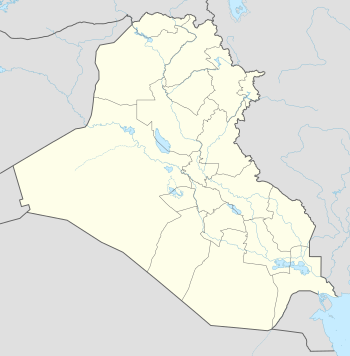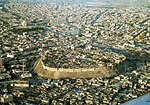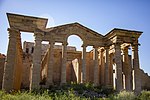
Hatra was an ancient city in Upper Mesopotamia located in present-day eastern Nineveh Governorate in northern Iraq. The ruins of the city lie 290 km (180 mi) northwest of Baghdad and 110 km (68 mi) southwest of Mosul. It is considered the richest archaeological site from the Parthian Empire known to date.
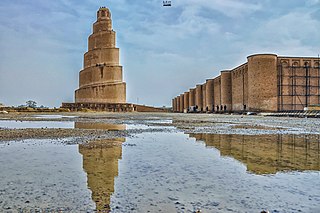
Samarra is a city in Iraq. It stands on the east bank of the Tigris in the Saladin Governorate, 125 kilometers (78 mi) north of Baghdad. The modern city of Samarra was founded in 836 by the Abbasid caliph al-Mu'tasim as a new administrative capital and military base. In 2003 the city had an estimated population of 348,700. During the Iraqi Civil War, Samarra was in the "Sunni Triangle" of resistance.

Aššur (; Sumerian: 𒀭𒊹𒆠 AN.ŠAR2KI, Assyrian cuneiform: Aš-šurKI, "City of God Aššur"; Syriac: ܐܫܘܪ Āšūr; Old Persian: 𐎠𐎰𐎢𐎼 Aθur, Persian: آشور Āšūr; Hebrew: אַשּׁוּר ʾAššūr, Arabic: اشور), also known as Ashur and Qal'at Sherqat, was the capital of the Old Assyrian city-state (2025–1364 BC), the Middle Assyrian Empire (1363–912 BC), and for a time, of the Neo-Assyrian Empire (911–609 BC). The remains of the city lie on the western bank of the Tigris River, north of the confluence with its tributary, the Little Zab, in what is now Iraq, more precisely in the al-Shirqat District of the Saladin Governorate.

The Great Mosque of Samarra is a mosque from the 9th century CE located in Samarra, Iraq. The mosque was commissioned in 848 and completed in 851 by the Abbasid caliph Al-Mutawakkil who reigned from 847 until 861. At the time of construction, it was the world's largest mosque. It is known for its 52 metres (171 ft) high minaret encircled by a spiral ramp. The mosque is located within the 15,058-hectare (37,210-acre) Samarra Archaeological City UNESCO World Heritage Site, listed in 2007.

Wasit was an early Islamic city in Iraq. It was founded in the 8th century by the Umayyad viceroy of Iraq, al-Hajjaj ibn Yusuf, to serve as the region's seat and as the garrison of the Syrian troops who enforced Umayyad rule there. It was situated between the two traditional administrative centers and garrisons of Iraq, Kufa and Basra, hence its name Wasit. The city was abandoned centuries later and its ruins are located in the eponymous Wasit Governorate, southeast of Kut in southeastern Iraq.

Iraq's 18 governorates are subdivided into 120 districts (kaza).
The World Heritage Earthen Architecture Programme (WHEAP) is a UNESCO initiative promoting earthen architecture founded in 2007 and running till 2017.

Tourism in Iraq refers to tourism in the Western Asian country Iraq. Iraq was one of the main destinations for many years, however it changed dramatically due to conflicts. The tourism in Iraq has faced many challenges, however, in recent years there has been improvements. The capital city Baghdad is the second largest city in the Arab world and the 4th largest in the Middle East. Iraq has several World Heritage Sites, dating back to ancient Mesopotamia, most notably Babylon Iraq. Iraq is considered to be a potential location for ecotourism. Erbil was chosen as "Arab Tourism Capital" in 2014 by the Arab Tourism Committee.

The Qushla or The Qishleh is an Ottoman site in Baghdad, Iraq. The Qushla lays at Rusafa side of the Iraqi capital. The Ottoman Wali (governor) Mehmed Namık Pasha started the building in 1881. The building was finished after him by the next Wali Midhat Pasha.

Al-Wazeer Mosque is an old mosque in Baghdad, Iraq, which is considered a cultural heritage building. The mosque was built by the Wazir of Baghdad Hassan Pasha in 1599 during the Ottoman era. Later the mosque witnessed several renovation and restoration works. The main characteristic of the mosque is its Ottoman architectural style. It is located in al-Rusafa district behind the Souk al-Sarai, near the riverbank of the Tigris River.
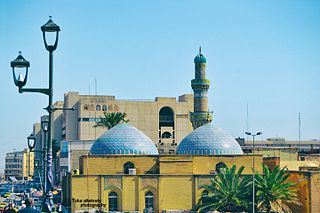
The Mosque-Madrasa of al-Asifyah is a complex of mosque and madrasa located near the riverbank of Tigris, in Baghdad, Iraq. The mosque and its associated complex including school buildings, old courts and other former government buildings, and a palace are contained within a 7.57-hectare (18.7-acre) site alongside the banks of the Tigris that forms part of a tentative UNESCO World Heritage Site.
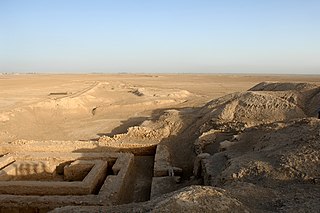
The architecture of Iraq encompasses the buildings of various architectural styles that exist in Iraq.
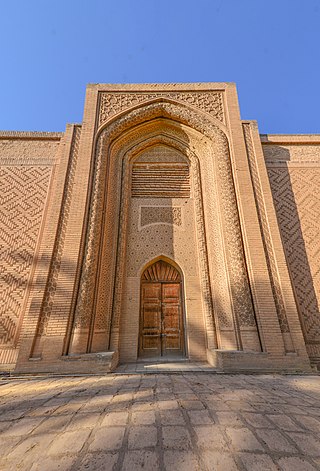
The Abbasid Palace is an ancient Abbasid complex and an Iraqi historical palace located near the Tigris river on al-Rusafa side of Baghdad, Iraq. North of al-Mutanabbi Street and a part of al-Maidan area. The palace dates back to the 12th century and was built by Abbasid Caliph al-Nasir and was used as a walkable and observant fort for the Caliph. The Abbasid Palace is one of the few remaining examples of Abbasid-era buildings in Baghdad along with al-Mustansiriya Madrasa, al-Khulafa Mosque, and more.
